Qu-Bit Electronix Chance and Mixology Eurorack Modules Review
Earlier this year, Qu-Bit Electronix announced a clutch of new modules, and we were lucky enough to get our hands on two of them: Chance and Mixology. Dave Gale plugs up some stereo and rolls the dice… Details Kit Mixology and Chance Manufacturer Qu-Bit Electronix Price Mixology: $399/£379. Chance: $279/£249 Contact Qu-Bit Electronix Web www.qubitelectronix.com […]

Earlier this year, Qu-Bit Electronix announced a clutch of new modules, and we were lucky enough to get our hands on two of them: Chance and Mixology. Dave Gale plugs up some stereo and rolls the dice…
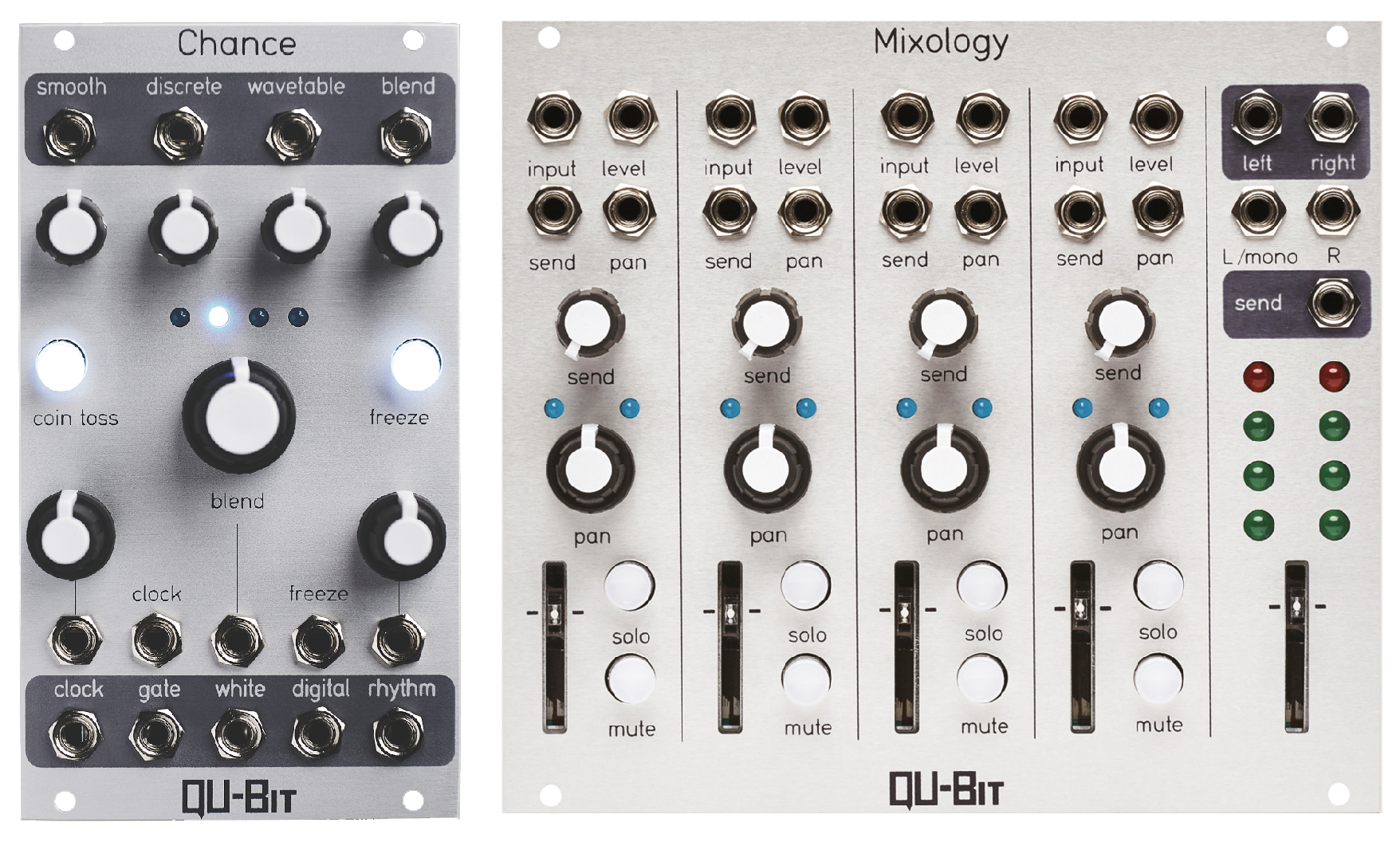


Details
Kit Mixology and Chance
Manufacturer Qu-Bit Electronix
Price Mixology: $399/£379. Chance: $279/£249
Contact Qu-Bit Electronix
Web www.qubitelectronix.com
![]()
If there’s one question that I rhetorically ask myself, it’s ‘Why are there not more mixers available in Eurorack form?’ and when I say mixers, I’m talking about audio mixers. I guess part of the answer could be because it’s so easy to just buy an external mixer to do the same task – but does it? Well, ‘no’, in a word. Because as any Eurorack fiend knows, especially ones who have a penchant for playing live, you want to have something in the rack that you can get at, and something that can be placed under CV control. Qu-Bit seeks to address this with their new module Mixology, which offers a solution to all of those wishes, and – wait for it – it’s got a stereo output.
Mixing it up
Starting with the basics, Mixology adopts the familiar Qu-Bit form factor; beautiful white pots and blue LEDs, all fronted on a stunningly sharp aluminium panel, with four familiar channels all offering a Mono input, to be drawn from your Eurorack. On the right, there is a single long-throw fader with LEDs above, forming a VU meter, in the familiar master-mix output that we all recognise. Coming in at 28HP, this is not exactly a small module – but then having the room to get in there and work is just what you’ll want, as I would shortly discover.
Looking at the four input channels, each is identical, with a long-throw fader at the bottom, also offering a Solo and Mute button alongside. Both of these buttons illuminate when pressed, and do so in a pop-free way, so you can ride these in a live set and not find any extraneous noise seeping through at any point. Above the fader is a Pan pot, with blue LEDs to visually register the signal from left to right.
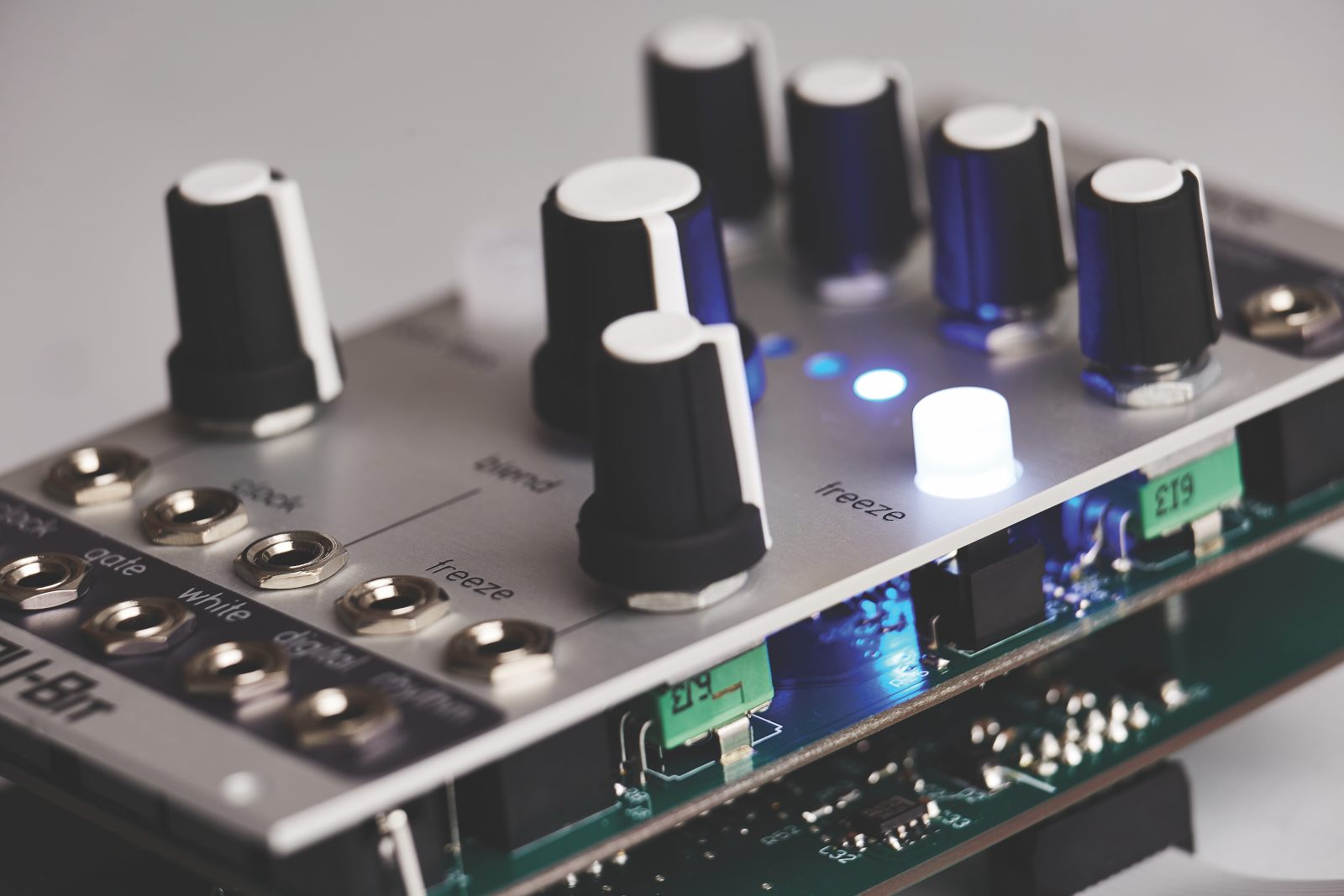
There’s an interesting little trick up Qu-Bit’s sleeve here, as the panning operation is augmented with constant power. So, regardless of position in the stereo field, perceived loudness is always upheld – you’ll be able to hear the signal, no matter where it’s placed.
Immediately above the Pan pot is a Send pot, which operates in the same way as a traditional Auxiliary send on a desk. The send signal is drawn from the mono source, with a mono/stereo return input available to the right of the module. There’s no return-signal level pot here, so the need might arise for attenuation of the signal elsewhere, before inputting back into Mixology.
CV control over stereo
So far, so much like a normal mixer: but the whole point of an Audio Mixer in your rack will be to take advantage of CV control, and although basic, as you would expect, the Mixology performs very well. Apart from the audio-signal input jack-point, three further jack-points per channel allow access to Level, Send Amount and Pan. A basic premise, such as patching an LFO to control pan, immediately finds the audio signal being thrown left and right across the stereo spectrum.
This could obviously be anything that your LFO can throw out, so basic stereo movement is easy, as is ping-pong style, left-to-right movement; simple, but somehow incredibly effective, in a domain where the stereo signal is often ignored. With a little further work with your LFO or Serge-style envelope device (such as a Make Noise Maths), you could find your panning bouncing around in all kind of ways.
It seems odd to get so excited about something as simple as CV control of panning, but there’s a reason why we like stereo – and that’s the space that is created in the depth of the audio stage. Your Eurorack could have a whole new lease of life as a result.
Not to be ignored, the Send CV control could equally have your signal being applied with FX, and then rapidly diminishing, in a controlled or random state. I’ve always liked this sort of thing, with reference to devices such as Mutable Instruments’ Clouds and Elements, so to have the ability to liberally apply effects across all four channels, is just great.
The long-throw faders themselves deliver attenuation of signal; or if pushed to the max, deliver a +3dB increase and can operate as VCAs in their own right. In my experimentations, I found the signal to be exceptionally clean until the master peaked; at which point, the distortion was clipped and digitally unpleasant, so my advice would be to keep signals away from the clip point.
Via the application of modulating signals, it’s possible to produce more conventional VCA/ADSR-style results, but also create patching that can deliver audio ducking. This throws open possibilities for ‘pumping’ style patches, which are easy to achieve in this environment.
The final summing
Not surprisingly, the Mixology is pretty easy to use if you have a basic knowledge of what an audio mixer does, but there’s no doubt that the bigger aspect of this module, at least for me,
is the simplest aspect that’s taken for granted elsewhere. I’ve never understood why mono signals rule to the extent that they do in Eurorack, with few companies really exploiting the stereo potential.
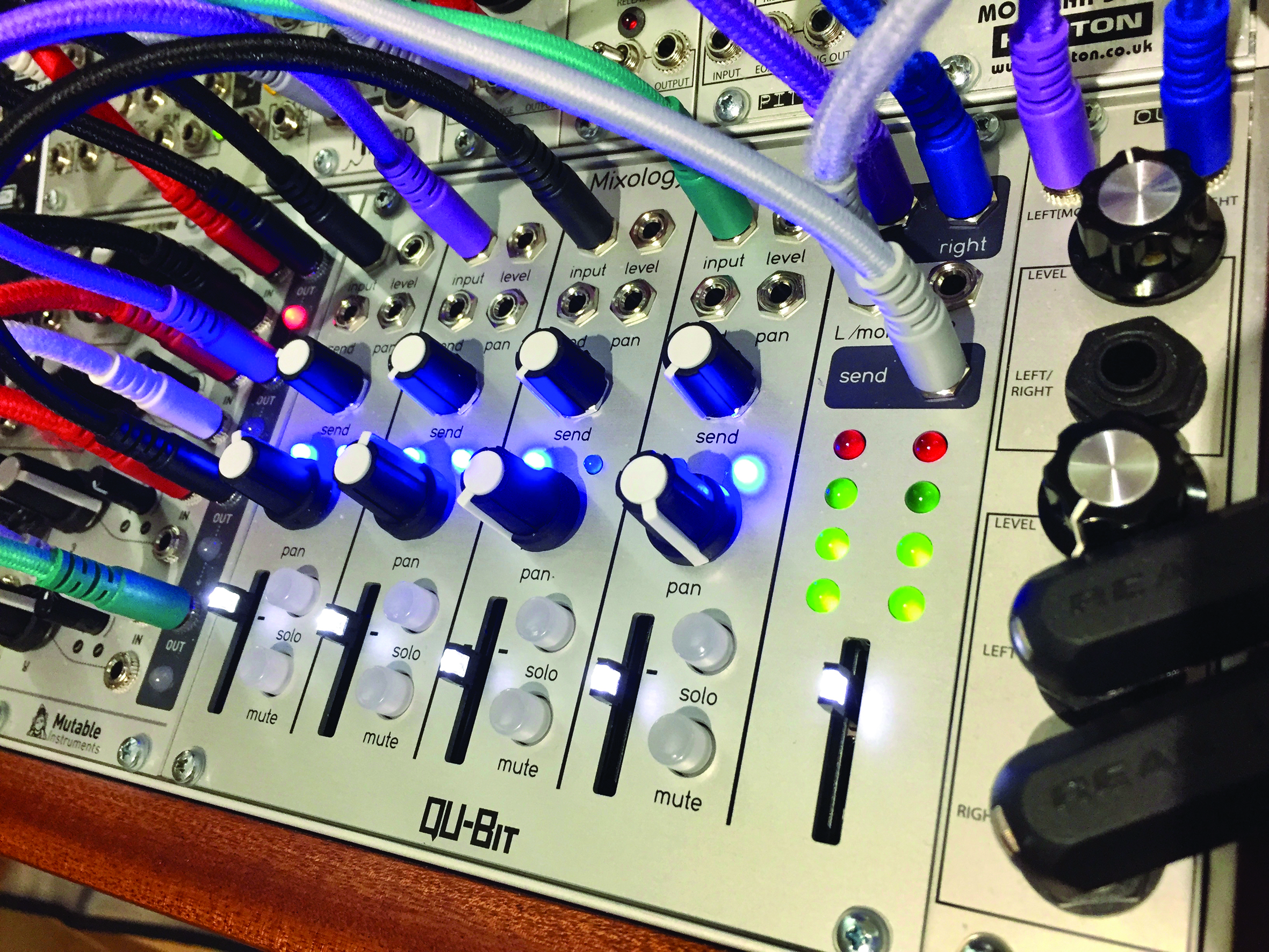
What Mixology does, effortlessly, is provide a simple way to get those mono signals into a stereo domain, adding depth and space to the field, and placing it under CV control. What’s not to like about that? Well, nothing – but if you couple this with the exceptional clarity of sound that the Mixology offers, it’s a must for any Eurorack and especially useful to anyone who plays live. Let’s face it: the future’s bright, and it’s in stereo.
Random chance
What is it about Random modules that appeals to me so much? I believe it started with the very first time I heard a Sample & Hold LFO modulating a filter, with a touch of resonance. Move on by some years, and I discovered the Music Thing Modular’s legendary Turing Machine in both Mk 1 and Mk 2 forms, which is possibly my favourite ever Eurorack module. Strange to have a favourite that doesn’t even make a noise (except for white noise), so you can imagine that when I heard about the new Chance from Qu-Bit, I was literally drooling at the prospect of getting my hands on one to review.
While what we have here looks very familiar, in that it also adopts a similar form factor to the Mixology and the other batch of current Qu-Bit modules, Chance is half the size of Mixology, but packs an awful lot into its 14HP form. Across the top, there are four output options, all of which are based around the generation of a random CV and with their own dedicated attenuverter pot.
Smooth and Discrete are essentially traditional Random LFO/S&H-style generators, with Smooth offering a vast amount of slew. In fact, here, the calculations are such that the movement glides from one destination voltage to the next with a speed of glide dictated by the clock, which is either controlled internally, or clocked from an external source. By contrast, Discrete steps in an un-slewed fashion. Next in line is Wavetable, and this is where we get a lot more chaotic!
The theory here is that the output is a continuously changing, tempo-synced LFO, but the reality is something quite wild – it’s so leftfield that it could use a little taming, and that’s exactly what the final output delivers. Blend links to the large pot in the centre of the module and enables the blending together of the three previously mentioned signals, in varying amounts, according to the location of the pot and the display of the four LEDs are directly above.
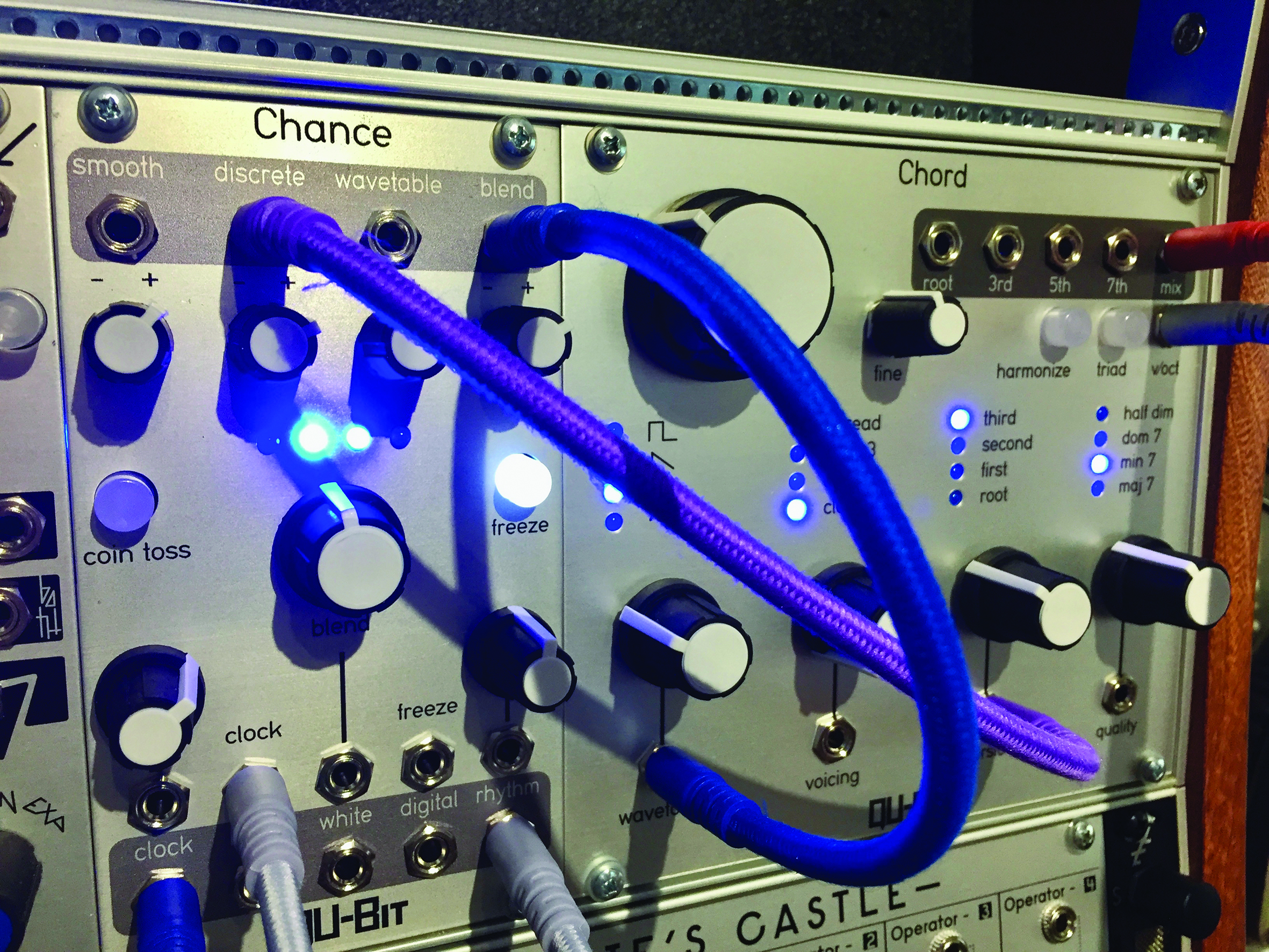
If turned all the way to the right, the CV output is an automated incarnation of the three, with the expected level of randomness; but under manual control, it’s possible to blend one output type with another, my favourite here being the mix of Discrete and Wavetable. I would liken this to some form of automated and randomised Aphex Twin programming, where beautiful S&H-style stepping can be interjected occasionally with the onslaught of the Wavetable. The results, for a random module, are unbelievably beautiful and in my view, exceptionally useful. I found myself in a creative zone quickly, itching to employ this CV modulation in a patch and commit it to audio.
Either side of the Blend pot are the Coin Toss and the Freeze button. Illuminating when pressed, the former is essentially like a reset for the random generators, re-seeding the values on offer, while the Freeze button will literally freeze the current value of randomisation. Using the two together can allow for random stepping to happen, with both being available to CV control. Using additional modules for further control, it would be possible to step through random CVs, creating random voltages in tandem with a given sequence pattern, adopting the sequencer’s rhythmic properties.
This is already a very comprehensive set of parameters. But as a bonus, the lower part of Chance offers further additional outputs, such as White Noise and Digital Noise. Both are useful,
with the Digital Noise output being in a continual state of bit-like flux. Very interesting and useful as a starting point for a number of timbral possibilities. Additionally, the Burst and Rhythm outputs deliver gate signals that can be used to trigger items elsewhere in the modular.
Burst delivers a randomly generated number of trigger bursts with every clock pulse, whereas the Rhythm output will deliver a more controlled set of pulses, according to the position of the pot located above it, which will in turn dictate the clock division of pulse, and is also available to CV control itself. This should be useful for various types of effects, including something akin to ratcheting.
Final roll of the dice
For a 14HP module, Chance really does pack quite a punch. I found it to be reasonably intuitive in use, with some excellent random CVs falling from every output (some more usable than others); although this is obviously dependent on what you are trying to achieve.
The additional outputs, such as Rhythm, open up some nice extended possibilities which, when linked with the main four random outputs, makes for a useful and desirable module. Chance was inspired by John Cage and his use of the Chinese Divination text, which arguably makes this module quite a West Coast-influenced affair, but I see it as applicable to all camps.
It can operate as a more regular clockable, random LFO, but it’s far more capable – some nice surprises often occur with trial and error, which in a sense, is the whole point of the module.
If you’re a fan of the whole concept of random generation, you’ll definitely want to have a look at this module, and for good reason.
It has loads to offer and won’t disappoint; although it would have been a nice touch to further allow the locking of a fixed number of steps, which for me would have been the real icing on the cake. However, maybe that 16-step mentality plays against the whole West Coast ideal, and I’m certainly not about to cause any friction between either camp, especially with a module as good as this. It’s another classic from Qu-Bit, and one I’ll be using plenty in the future.
Two’s company
I’ve always loved Qu-Bit’s modules, and these two simple, but effective, devices will find homes in any Eurorack. The build, the sound, the purity of design and the form factor all add up to great quality, and they fill some great holes, not only in your own rig, but in the modular marketplace, too. They’re a little larger than some of the competitors, but everyone I know who likes these modules talks about this in a very positive way. They’re larger, but they are very clear to use, and if you’re into live performance with modular, that will be a major draw.
Alternatives
The main competitor to Mixology is Intellijel’s Mutamix, which is a current favourite with many live performers. There are notable differences, the main one being that Mutamix will allow for the saving of certain settings, but unlike Mixology, does not handle stereo, at least not in the same way, as there’s no immediate panning control. There are ways around this, but the immediacy with which it’s available on the Mixology makes it very appealing. The Mutamix also offers six inputs against the four on the Mixology (five, if you include the Aux return!)
Up against Chance, the undisputed leader is Music Thing Modular’s Turing Machine, now in its Mk 2 revision. The Turing is a kit, so you’ll either need to make one up yourself, or buy from somebody who has done this for you. There is a plentiful supply of various flavours of Turing Machine on the usual auction sites, but there are a number of expanders, which are sold separately, or can be fitted to single panels which are made by third parties.
This is where the Chance excels, because some of the additional features, which are similar, appear on the Chance as standard, and you won’t have to make them yourself, so the build quality can be assured. Having said that, I think there’s room for both flavours in your modular, although the Turing will require an external clock source to be fed before working, whereas the Chance has its own, built right in.
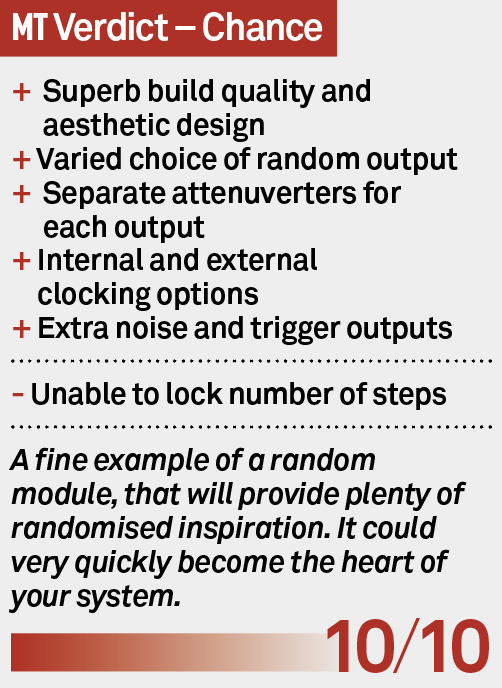
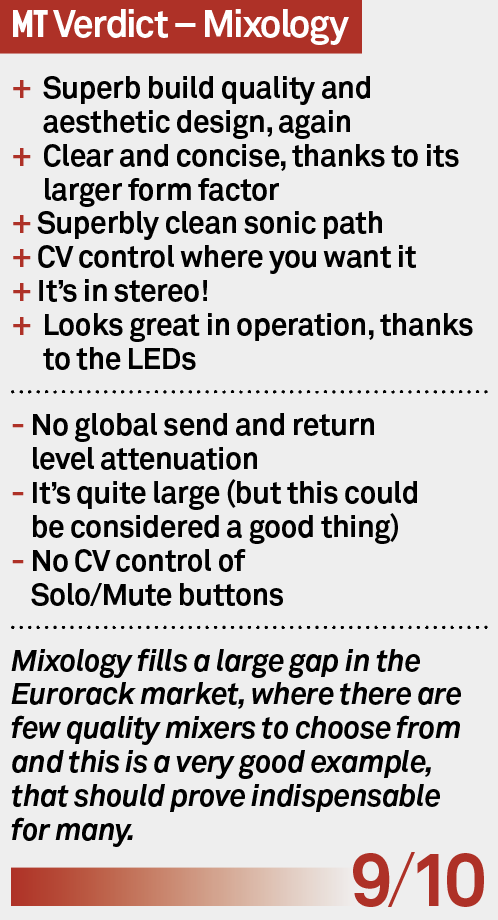
Chance key features
- 4 random voltage outputs with attenuverters
- ‘Freeze’ operation
- Noise outputs onboard
- Clockable
- Width: 14HP
- Current draw: +12v: 45mA / -12v: 17mA
- Module depth: 34mm (skiff friendly)
Mixology key features
- 4-channel mixer in Eurorack format
- ‘Pop free’ Solo and Mute on all channels
- CV control of levels and panning
- Stereo output
- Width: 28HP
- Current draw: +12v: 174mA / -12v: 55mA
- Module depth: 23mm (skiff friendly)
